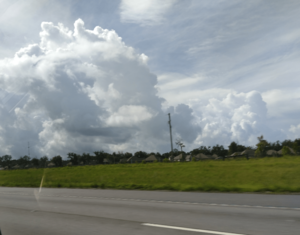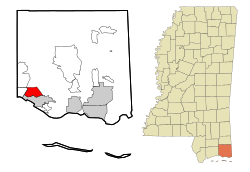Gulf Hills, Mississippi facts for kids
Quick facts for kids
Gulf Hills, Mississippi
|
|
|---|---|
 |
|

Location of Gulf Hills, Mississippi
|
|
| Country | United States |
| State | |
| County | Jackson |
| Area | |
| • Total | 8.23 sq mi (21.31 km2) |
| • Land | 7.74 sq mi (20.03 km2) |
| • Water | 0.49 sq mi (1.27 km2) |
| Elevation | 13 ft (4 m) |
| Population
(2020)
|
|
| • Total | 8,526 |
| • Density | 1,102.26/sq mi (425.57/km2) |
| Time zone | UTC-6 (Central (CST)) |
| • Summer (DST) | UTC-5 (CDT) |
| ZIP code |
39564
|
| Area code(s) | 228 |
| FIPS code | 28-29620 |
| GNIS feature ID | 0670768 |
Gulf Hills is a small community in Jackson County, Mississippi, United States. It's known as a census-designated place (CDP), which means it's a special area defined for gathering population data. Gulf Hills is part of the larger Pascagoula area. In 2020, about 8,526 people lived there, which was more than in 2010.
Contents
Where is Gulf Hills?
Gulf Hills is located right on the Mississippi Gulf Coast. It's just south of a big highway called Interstate 10. To its west is a place called St. Martin, and to the north is Latimer. The city of Ocean Springs is to the south.
Pascagoula is about 18 miles (29 km) to the southeast. Biloxi is about 6 miles (10 km) to the southwest, across Biloxi Bay.
The area of Gulf Hills covers about 8.2 square miles (21.1 square kilometers). Most of this is land, but about 0.5 square miles (1.3 square kilometers) is water. Even though it's close to the Gulf of Mexico, some parts of Gulf Hills are a bit hilly. The land can be from sea level up to 25 feet (7.6 meters) high.
A Look at History
The area now known as Gulf Hills was once called "Bayou Puerto." In the mid-1800s, it was a small, quiet settlement. Most people living there were Roman Catholic. They made their living from the sea and the forests.
People fished, caught crabs and oysters, and used boats for travel and trade. Others cut down trees and made charcoal. Some families grew citrus fruits and grapes, and everyone had vegetable gardens. Their main food was seafood, birds, and wild game. After 1900, fewer people made charcoal, and most men worked in the seafood industry.
From Bayou to Resort: The Millionaires' Playground
In the mid-1920s, something big happened that changed Bayou Puerto forever. A group of wealthy investors from Chicago and New York loved the beautiful scenery and warm weather. They decided to build a winter resort there. They called it "Gulf Hills" because of the small hills created by streams flowing into the bayous.
Harvey W. Braniger, a developer from Chicago, is seen as the founder of Gulf Hills. The resort officially started in 1925. The developers wanted to sell large homesites to rich people from the northern states. These people would come to escape the cold winters.
In 1927, Gulf Hills opened with a big party. It was called the "golf city of the Gulf Coast." The resort covered 667 acres (2.7 square kilometers). A large part of this land was used for golf courses, parks, and waterways.
However, the Great Depression slowed down their plans. By the end of World War II, there were only about 40 homes in Gulf Hills. Building started again in the 1950s and continued through the 1960s and 1980s.
The Gulf Hills Inn was later changed into the Gulf Hills Dude Ranch, with a fun western theme. It became a very popular place, known across the country. Famous people like Judy Garland and Elvis Presley visited. Even honeymooners like Mary Ann Mobley and Gary Collins enjoyed staying there. For a while, even some organized crime leaders would meet there, but they were so quiet that most people didn't even notice them.
Today, most people live in Gulf Hills all year round. It's now a diverse community, not just a resort for visitors.
Who Lives in Gulf Hills?
The population of Gulf Hills has grown over the years.
| Historical population | |||
|---|---|---|---|
| Census | Pop. | %± | |
| 2000 | 5,900 | — | |
| 2010 | 7,144 | 21.1% | |
| 2020 | 8,526 | 19.3% | |
| U.S. Decennial Census | |||
In 2020, there were 8,526 people living in Gulf Hills. These people lived in 3,072 households, and 2,218 of those were families.
People in Gulf Hills (2020)
| Race | Number of People | Percentage |
|---|---|---|
| White (not Hispanic) | 5,562 | 65.24% |
| Black or African American (not Hispanic) | 1,317 | 15.45% |
| Native American | 21 | 0.25% |
| Asian | 597 | 7.0% |
| Pacific Islander | 6 | 0.07% |
| Other/Mixed | 535 | 6.27% |
| Hispanic or Latino | 488 | 5.72% |
Safety and Services
Fire Department
The Northwest Jackson County Fire Department helps keep the community safe by providing fire protection.
Law Enforcement
The Jackson County Sheriff's Office is in charge of law enforcement and keeping the peace in Gulf Hills.
Schools in Gulf Hills
Students in Gulf Hills attend schools that are part of the Jackson County School District. These schools are located in nearby St. Martin.
Elementary Schools
- St. Martin North Elementary
- St. Martin East Elementary
- St. Martin Upper Elementary
Middle Schools
- St. Martin Middle School
High Schools
- St. Martin High School
More Information
You can find more information about Gulf Hills on its official website: gulfhills.org
See also
 In Spanish: Gulf Hills para niños
In Spanish: Gulf Hills para niños


